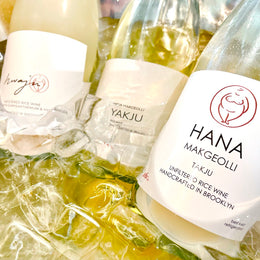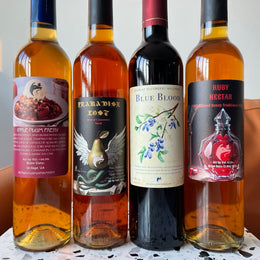Tasting Testing The Most Recognisable Shochu: iichiko Sihouette いいちこシルエット , WAPIRITS Tumugi, iichiko Special いいちこスペシャル

If you frequent Japanese eating spots often, chances are you've came across a stout, grey bottle with a brown cardboard-esque label sitting at the shelf or countertop. Subtle, blending in with the dim backdrop of the bar; yet, the word "iichiko" just somehow sticks in your mind, refreshed at every turn of the drinks menu.

Izakaya bar shelf. Source: Travel Restaurant Hotel

Most izakayas and bars worth their salt would always stock a shochu - known for its crisp, refreshing and dry flavours to cleanse the palate, yet versatile enough to be chased with lemon or oolong tea.
And the go to option for that shochu is typically the iichiko Silhouette.
![]()
Source: Forbes
What's the story behind this seemingly ubiquitous shochu?
Three (Then Four) Families, One Shochu
The story of iichiko shochu begins in Usa City of Oita Prefecture. Three sake families; Akamatsu Honke Shuzo 赤松本家酒造, Kumanomido Shuzojo 熊埜御堂酒造場, and Wada Shuzojo 和田酒造場が参加; founded the Sanwa Shurui 三和酒類 in 1958 as a joint bottling facility: with San 三and Wa 和 translating to "three" and "harmony" respectively. Collectively, the sake families would produce sake under the unified Wakabotan 和香牡丹brand. In the following year, a fourth sake family, Nishi Shuzojo 西酒造場, joined the group.
![]()
The founders of the three sake families at the time of founding. Source: style.iichiko.co.jp
Officially, the four sake families would merge in 1972, and would continue producing sakes since the time of founding for the next 20 years. However, the founders faced increasing difficulties continuing the sake trade in the face stiff competition, as more major sake brewers opened within the Kysuhu region and competed on price. The price wars meant that sake production and sales was no longer viable, where they then decided on a bold move: with a 20 million yen investment, the four families shut down their sake breweries, and collectively switched over to producing shochu, despite never having done produced the distilled spirit before.
![]()
When Nishi Shuzojo joined the three families, the group brewed sake under the unified Wakabotan Brand, as seen on the water tower. Source: iichiko
Back then, the climate of shochu was vastly different - shochu was typically strong in aroma and taste. At the same time, shochu had the perception of being "cheap". However, coming into the 1970s, lots of innovation of shochu became available to producers: low pressure distillation that distilled fruitier and more volatile compounds, chill filtration that removed oilier and stronger flavoured compounds and so on. That didn't mean that the company could produce great tasting shochu right away - they wanted to create something lighter, fruitier, and easy to drink with no peculiarities.

An old advert (~1977) for shochu. Source: Takara Shuzo
Whilst sake (which is made from rice) was Oita Prefecture's most widely produced alcoholic drink for the longest time, barley has been grown in Oita Prefecture for decades - with the abolition of barley control laws for Oita Prefecture in 1951 enabling barley koji to be made. This prompted Sanwa Shurui to use barley for their shochu - opting for 100% barley that was distilled once, qualifying as honkaku shochu. In 1979, the first shochu made its debut.
![]()
The very first iichiko - the iichiko 25% Shita No Napoleon. Source: iichiko
Sanwa Shurui's first version of its barley shochu needed a name - and hence, the company asked the people of Oita prefecture. According to Sanwa Shurui, more than a thousand postcards flooded to the office, each bearing a proposal to name Oita's new to come barley shochu.
![]()
Source: style.iichiko
A postcard wrote "iichiko いいちこ" - which in Oita dialect translates to "It's good", with the suffix "-chiko -ちこ" being a main characteristic of the dialect. The product's nickname would arise from this crowdsourced effort, the "Shitamachi no Napoleon 下町のナポレオン.
![]()
During the initial sales of iichiko "Shitamachi no Napoleon ", there were calls by department stores to change the name to something less "silly and humourous". However, when Sanwa Shurui changed the tagline, customers strongly resisted the change and the moniker came back to the packaging.
The release of iichiko could not have came at a better time either. This was during Oita Prefecture's "One Village, One Product 一村 一 品運 動" movement, aimed to showcase the specialty produce from the prefecture. Every prefecture in Kyushu had something to showcase: Kagoshima had their sweet potatoes, Miyazaki had their buckwheat, Kumamoto had their rice, and for Oita, it was going to be barley.
![]()
Governor Hiramitsu's "One Village One Product" model was widely replicated outside of Japan. Source: OVOP Japan
The movement was kickstarted by then 1975 Vice Governor of Oita Prefecture Morihiko Hiramatsu, who then was elected to Governor. According to the late Chairman of Sanwa Shurui Nishi Taichiro, the governor often had a bottle of iichiko at hand when promoting Oita's products across the country, which he mentioned greatly helped spread the word of iichiko shochu.
A Picture Says More Than A (Typical) Advertisement Would
Whilst there was increasing interest in shochu during the 1980s and 1990s, perhaps it was iichiko's masterful targeted marketing that established its position as Japan's most widely sold shochu for most of the 1990s to 2010s.

Hideya Kawakita and his Tokyo Subway Map (1972). Source: Sanwa Shurui
Enter Hideya Kawakita - and art designer by profession (who also designed the Tokyo subway line map back in 1972). was commissioned by Sanwa Shurui in 1983 to helm the design and promotional materials for the budding iichiko brand. One condition however - Sanwa Shurui could not interfere with the design process. Kawakita wanted iichiko to spread by word of mouth, and through his market research, found that it was mostly men in their 40s, with a handsome annual income of 6 million yen, and readers of the Nihon Seizai Shimbun (Nihon Economic Newspaper) that were avid fans of the shochu.

Tokyo Subway in the 1980s. Source: r/Sputnikoff
For the first wave of advertisements, Kawakita took to the subway stations, where he erected posters along the walls. This went against convention wisdom, especially within the media-rich environment where magazines covers, television and radio ads were commonplace. With the "word-of-mouth" goal in mind, the first iichiko poster placed a bottle of iichiko amongst antique furniture, with a copy that read:
![]()
"We live in an advertising world, but there is an alcohol that people drink on rumor alone. Mismatched Story."
Then, Kawakita took to nature - quite literally, planting bottles of iichiko shochu amidst serene nature backdrops with little promotional text.
![]()
One of the most iconic nature-themed iichiko posters debuted in January 1986. A true sight for sore eyes. Source: iichiko
Kawakita reasoned, that with these peaceful, picturesque murals of nature placed in dreary, greyed and bleak environments (such as the interiors of the Japanese subway, where most of these high-flying salarymen would frequent), the scenes of nature and serenity evoked a sense of calm and relaxation for those who stopped to view them. That was the spirit of iichiko - easy drinking, relaxing, and meant to soothe and calm, befitting of the shochu's light, fruity and refreshing taste profile.
![]()
iichiko poster, March 2025 edition. Source: iichiko
And perhaps there's something timeless with depicting nature - so much so that since 1985, iichiko and Sanwa Shurui has continued the tradition of releasing a poster every month in the iichiko poster calendar till this day! Beyond nature, iichiko's branding included the bottle being in curiously ordinary spots, such as within someone's fridge, a sushi countertop, or within a spacious living room.

Kawakita worked closely with his late university friend and glass artist Koji Ishii to design and produce the Silhouette bottle. Source: Aomori Museum / Ishii-Glass Studio
Apart from the captivating posters, Kawakita also led the designs of the iichiko glass bottles - with the iichiko Silhouette being the first bottle he designed back in 1985. In an interview with Koji, Kawakita revealed that a restaurant owner requested the Silhouette to fit on the shelves where whisky bottles stood. Taking that inspiration, the iichiko Silhouette, being a new and novel shochu that was breaking old stereotypes, had to look "strong" and comparable to its Western spirit peers, yet lowkey and approachable the same time. Talk about opposing design themes!
Kawakita would then go on to lead the design of the other iichiko editions.

A few standouts of Kawakita's bottle designs, including the iichiko Flask, iichiko Super, and the iichiko Super 40.
iichiko has since expanded its marketing styles beyond just posters and bottle designs - Kawakita started and was the chief editor of the "iichiko Quarterly (季刊 iichiko)" magazine that featured Japanese folklore, culture and other topics like hospitality.
![]()
Archives of the iichiko Quarterly. Source: bijutsutechno
iichiko also runs an extensive blog on its website featuring staff member interviews, behinds the scenes work at the distillery; and more recently, iichiko has an annual "iichiko Story" since 2021. An exhibition "iichiko Design Week 2024" has recently been organised to showcase 40 years of the brand's design philosphy.

For the 2024 and 4th edition of iichiko Story, which celebrates 40 years since iichiko posters were placed in subway stations, an animated short with character designs by Masami Yuki was produced: depicting Tamaki inheriting her grandfather's carpentry tools.
With all that said, let's get to tasting iichiko's shochus! We had the chance to taste the iichiko Silhouette いいちこシルエット , WAPIRITS Tumugi , and the iichiko Special いいちこスペシャル at multiple occasions, all courtesy of Sake Inn Singapore.
iichiko Silhouette | いいちこシルエット , 25% ABV
![]()
Source: style.iichiko
Starting out with the most iconic of them all - the iichiko Silhouette. iichiko Silhouette was made using two-row husked barley (sourced from Oita Prefecture and Australia).

Oita Barley. iichiko uses the two-row variety. Source: iichiko
Like sake, the barley grains are first polished down to remove some of the outer layers, then steamed, inoculated with koji, before fermenting into a mash which then undergoes distillation.
![]()
Stills from Sanwa Shurui. Source: style.iichiko
iichiko Silhouette uses a combination of both atmospheric distillation (jo-atsu) and vacuum distillation (gen-atsu, also known as low-pressure distillation). The mash that undergoes jo-atsu, and like how distillation is conventionally done around the world, distills at a high temperature and yields robust, strong flavours. However, with gen-atsu, that distills at a lower pressure, decreases the boiling point at which ethanol boils - hence, allowing more volatile organic compounds to be distilled together with the ethanol, yielding a lighter spirit.
![]()
Jo-atsu (left) and Gen-atsu (right). Source: style.iichiko
Both distillates are blended together, alongside with groundwater from deep underneath Usa City - where the slightly soft water has underwent much filtration through volcanic rocks. iichiko Silhouette is blended to 20% ABV.

Nose: On the nose, it is has a slight stony, asphalt aroma on the nose. The aroma is reminiscent of that smell you get when you dunk water onto white hot charcoal – the intermingling of smoke and steam. After the initial stone, hot asphalt aroma, there is a floral yet grainy aroma to the nosing – like a mix of rose water and rice porridge.
Taste: The shochu starts out quite gentle, having a bit of a shisho leaf flavour at first. Textually, is is refreshing, like slightly soft mineral water. There are rice porridge flavours present here too, with a very slight inkling of green banana.

Finish: The finish is very light and gentle, though slightly saline in character. It leaves a bit of a moreish, thrist-inducing quality.
Thoughts
It’s no wonder why this shochu is a favourite amongst bars. It may be simple, but I argue that there’s a speciality in it’s texture – it quenches your thirst, while leaving you wanting for more! From critical perspective, it embodies such a clean profile that if almost feels like it tastes like nothing, but within the context of greasy food, a post-work tipple, or even as a midday drink, this on the rocks would feel like heaven.
You’ll probably catch me chasing this on ice, masquerading this as a glass of cold water.
WAPIRITS Tumugi | TUMUGI ジャパニーズワピリッツ , 40% ABV
![]()
Tumugi is iichiko's answer to the bartender scene. The brand tagline reads as follows: "Gin from U.K., Vodka from Russia, Rum from Cuba, Tequila from Mexico, and WAPIRITS from Japan", positioning WAPIRITS as the next core bottle for any bartender worth their salt to have on their bar bench.
![]()
Tumugi at Bar Benfiddich, ran by Hiroyasu Kayama. Source: Asahi
Unlike honkaku shochu, where the shochu is only distilled once, Tumugi goes through two distillation runs. The first distillation run starts out like a normal shochu: barley is inoculated, fermented, then distilled once. At the second distillation run however, botanicals are macerated into the first distillate: kabosu (a citrus fruit) and mint from Oita, lemons from Ehime, mandarin oranges from Shizuoka and yuzu from Koichi.

Botanicals used in Tumugi.
There are multiple versions of Tumugi, but we will be tasting the original, bottled at 40% ABV.

Nose: A strong, toasty yet funky aroma on the nose, reminiscent of miso paste, but keeping only the funk and none of the savouriness. Behind that funky aroma, the fragrance of banana bread topped with walnuts takes over. After letting the shochu sit a bit, there is a whiff of bitter lemon.
Taste: Quite a fiery heat on the palate, with a strong nuttiness as well, reminding me of toasted sesame, burnt sugar, and pan-fried oats. A tickle of citrus makes its way on the tongue, this time remind me of the flesh of kaffir lime.

Finish: The funky, savoury flavours take precedent here at first, giving toasted rice that are borderline charred. Then, it slowly peels away, where that citrus aroma makes a return here in the form of fresh lemon peels.
Thoughts
It makes sense that this shochu designed for mixing rather than for drinking neat. It greets you on the tongue is a way that is quite fiery, but from you get past that fiery trial you do get a myriad of interesting flavours – some banana bread, some citrus. If iichoko claims they were making this as a cocktail spirit, they certainly weren’t kidding. I would think the multi dimensional flavours could pop off differently across a variety of cocktail styles.
iichiko Special | いいちこスペシャル , 30% ABV
![]()
Source: iichiko
Now before we get into the iichiko Special, let's talk yeast.
Just like sake, shochu requires yeast to convert sugars to alcohol - whilst also creating a whole host of other aromatic and flavour organic compounds. And just like sake, there are special yeasts that a bred, cloned and available for purchase to tailor a shochu's desired profile. These yeasts are made available by the Brewing Society of Japan, or at prefecture technology centres and labs.
![]()
Yeast activity in a fermentation tank. Source: style.iichiko
However, for Sanwa Shurui, they have cloned their own special yeast - which they manage to isolate! It started during the 1980s where Sanwa Shurui employs a method called "sashimoto 差し酛", where yeast starter from one batch is transferred into the next batch. This was to ensure a more stable fermentation - preventing unwanted bacteria from propagating. However, the staff at the distillery found out that a yeast strain was slowly taking over the conventional shochu yeast in numbers, eventually overtaking the original shochu yeast in alcoholic production!
The first strain of yeast was discovered within the distillery, named "iichiko Yeast BAW-6", which formed the basis of other clones and strains of yeast within the distillery.
![]()
Yasuhiro Kajiwara, with a bottle of iichiko Special. Source: style.iichiko
Now, let's talk about the iichiko Special - we're going to get technical so stay with me. In an article by Yasuhiro Kajiwara of the Sanwa Shurui Research Institute, explained that barley grains contain ferulic acid, which when underwent a decarboxylation reaction (removing a CO2 molecule from organic acids), becomes 4-vinylguaiacol (4-VG). When 4-VG undergoes oxidation, it is converted to vanillin, the aromatic molecule associated with vanilla.
![]()
The process of ferulic acid transforming to vanillin. Source: style.iichiko
4-VG gets oxidised and converted to vanillin during the storage process after distillation - however, most shochu yeasts are unable to convert (or more accurately, decarboxylise) feruilic acid to 4-VG in the first place. It is discovered that one of Sanwa Shurui's yeast strains TSH-1, the result of cross-hybridising a shochu and wine yeast, was able to do just that, unlocking a vanilla flavour and aroma in barley shochu. To further this vanillin note, the shochu is aged for typically 5 years, in white oak.
![]()
Barrels of shochu. iichiko Special isn't the brand's first rodeo with barrel aging, being done in the iichiko Super 40 from earlier. Source: style.iichiko
The first release of the iichiko Special was in 2005 - and you may have noticed that there's a lack of label. That again is by design by none other than Katakiwa - the lack of label was meant to show off the shochu's amber colour, with all the necessary information concentrated at the neck of the bottle.

Nose: Vanillic with a hint of estery fruits - caster sugar infused with spent vanilla pods, vanilla flavoured cream, and bourbon cream. Hints of banana candy, strawberry gummies and tropical gum starts out subtle at first, but on subsequent nosings, becomes increasingly present.
Taste: Sweet and slightly bitey- initially drying with flavours of oak chips and hay stalks, before developing towards dessicated apples and pineapple. It gets a bit minerally afterwards, giving stony flavours of spring and mineral water.

Finish: The finish takes on a grainy, cereal-esque sweetness, like sweetened wheat biscuits, wheat flake porridge and steamed shokupan bread. There is a starchy maltiness on the finish as well, like cracked wheat germ.
Thoughts
Vastly different from the standard shochu! Interestingly, I do get accents that strike me very similarly to gins and shochus that has had some time in bourbon barrels - that bourbon cream, vanilla and confectionery tropical flavours that are imbued into the spirit.
The barrel influence greatly overpowering, and surprisingly so. This shochu comes across as still being pretty gentle, with that mineral water quality being preserved. It's interesting and definitely worth a try, especially when comparing to the other iichiko shochus!
Conclusion
Full disclosure here - the iichiko Silhouette does bring a tinge of nostalgia for me. The iichiko Silhouette was one of my very first alcoholic drinks enjoyed while I was coming of age - and the core memory of chowing down grilled chicken thigh skewers with the ice cold, almost mineral water iichiko Silhouette on the rocks is something I look back fondly to.
Sentimental musings aside, I feel that iichiko Silhouette really earned its place as being one of the most widely sold and recognisable shochus today. For someone trying shochu for the first time, there are very few shochus that offer a similarly friction-less, easy to approach, and more importantly refreshing, crisp experience that just so happens to be widely available. And for the shochu fans who've had tasted many shochus, there's something timeless and classic about the iichiko Silhouette that is always worth paying a visit to.
![]()
Most of the iichiko range. Source: iichiko
I do appreciate that iichiko has been innovating past the Silhouette - and I do look forward to trying some of the older variants like the iichiko Super and perhaps the OG iichiko Shitamachi no Napoleon someday!

@vernoncelli







